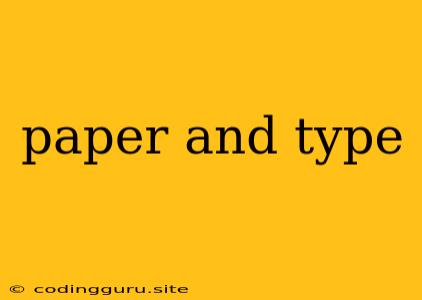The Perfect Pairing: Paper and Type
The art of communication is a delicate dance between the message and its delivery. While the words themselves hold the heart of the message, the paper and type chosen for their delivery play a crucial role in shaping the reader's perception. This is why the selection of paper and type is not just a technical detail, but a crucial artistic decision.
Paper acts as the canvas for the message, influencing its visual impact and setting the overall tone. The texture, weight, and color of the paper contribute to the reader's sensory experience, impacting how they engage with the content. A rough-textured paper might evoke a sense of authenticity and tradition, while a smooth, glossy paper might project a modern and sleek aesthetic.
Type, the visual representation of the written word, plays a crucial role in communicating the tone, personality, and style of the message. The choice of typeface can drastically alter the reader's perception. A bold, sans-serif type might convey strength and modernity, while a flowing, serif type might suggest elegance and tradition.
So how can you effectively pair paper and type to create a cohesive and impactful message?
Choosing the Right Paper
Paper comes in a wide array of styles and textures, each offering a unique visual and tactile experience. Consider the following factors when choosing the paper for your message:
- Weight: Paper weight, measured in grams per square meter (gsm), dictates its thickness and sturdiness. Heavier paper feels more substantial and luxurious, while lighter paper is more economical and suitable for everyday use.
- Texture: The surface of the paper can be smooth, textured, or even embossed. Smooth paper provides a clean and modern look, while textured paper adds visual interest and tactile appeal.
- Color: The color of the paper influences the overall tone of the message. White paper is a classic choice for its neutrality, while cream or off-white paper can convey warmth and sophistication.
- Finish: Paper can have various finishes, including matte, gloss, or uncoated. A matte finish provides a subtle, natural look, while a gloss finish adds shine and vibrancy.
Selecting the Perfect Type
Type selection is equally critical to crafting a compelling visual message. Here's a breakdown of key factors:
- Typeface: The basic design of the type is known as the typeface. There are countless typefaces available, each with its distinct personality and visual appeal. Some popular typeface categories include:
- Serif: These typefaces have small decorative strokes called serifs at the ends of their strokes. They tend to be more traditional and formal.
- Sans-serif: These typefaces lack serifs, creating a clean and modern look.
- Script: These typefaces mimic handwriting, adding a touch of elegance and personality.
- Display: These typefaces are designed for large-scale use, such as headlines and titles.
- Weight: The weight of the type refers to its thickness. Bold type commands attention, while light type is more subtle and delicate.
- Size: The size of the type is crucial for readability. Choose a size that is large enough for the reader to easily discern the words.
- Spacing: Proper letter spacing (kerning) and line spacing (leading) ensure optimal readability and visual appeal.
Finding the Perfect Harmony
The secret to effective paper and type pairing lies in achieving a balance between the two. They should complement each other without overwhelming or contradicting the message. Consider these tips:
- Matching tone and style: Choose a paper and type that align with the tone and style of your message. A formal occasion might call for a heavier paper with a traditional serif typeface, while a casual message might be more suited to a lighter paper with a modern sans-serif typeface.
- Contrasting for visual impact: Sometimes, contrasting paper and type can create a powerful visual statement. For example, a dark paper paired with a light type can draw attention to the text.
- Prioritizing readability: Ultimately, the most important factor is ensuring that the chosen paper and type promote readability. Choose a combination that allows the reader to easily absorb and understand the message.
Examples of Successful Pairings
- Wedding invitation: A thick, textured paper with a delicate, flowing script typeface creates a romantic and timeless feel.
- Modern marketing brochure: A glossy, smooth paper with a bold, sans-serif typeface conveys a sense of professionalism and modernity.
- Handwritten letter: A textured, cream-colored paper paired with a simple, cursive typeface evokes a feeling of authenticity and warmth.
Conclusion
The choice of paper and type is an integral part of effective communication. By carefully considering their visual and tactile impact, you can create a message that resonates with your audience and leaves a lasting impression. Whether you're crafting a formal invitation or a casual note, remember that the perfect pairing of paper and type can elevate your message to new heights.
